The one hundredth episode of any television show should be a cause for celebration.
After all, one hundred episodes exists at a number of interesting points in the life of a show. It tends to arrive late in the fourth season or early in the fifth season of a twenty-odd-episode-a-season series, meaning that any television show making it to that point has amassed some cultural cache. By that stage, most of the original contracts are expiring (or close to expiring) and so there is at least some sense as to how secure the future is. One hundred episodes also marks the series as viable for syndication; one hundred episodes airing five days a week can fill substantial airtime.

Ice to see you again.
To be fair, the other Star Trek series tended to mark the occasion with some low-key celebrations. The one hundredth episode of Star Trek: The Next Generation was Redemption, Part I, which was primarily notable for reasons behind the camera; both a set visit from Ronald Reagan and the end of the fourth season that had so frustratingly eluded the original series. Star Trek: Deep Space Nine marked both its one hundredth hour (The Ship) and its one hundredth episode (… Nor the Battle to the Strong) as “business as usual.”
However, Star Trek: Voyager turns its one hundredth episode into an epic event. It is the perfect distillation of the “Voyager as blockbuster Star Trek” aesthetic championed by Brannon Braga: a truly jaw-dropping computer-generated action scene, with Voyager crashing on the surface of an ice world; a high-stakes time-travel plot, with a killer hook; a guest appearance from a beloved Next Generation actor. Timeless is an incredibly ambitious piece of television that practically screams “this is a very special occasion!” to the audience at the top of its lungs.

LaForging ahead.
And, yet, for all of that, there is something decidedly funereal about the episode. The episode opens with the memorable shot of the eponymous starship buried under the ice on some forgotten and unnamed world. The crew are long dead, but the ship itself remains preserved and trapped in amber. While Timeless might eventually end with future!Kim changing the timeline and shaving ten years off the journey, the episode’s most iconic images are destructive: Voyager crashing and bouncing, the familiar sets encased in ice.
This is not a birthday party, it is a wake.
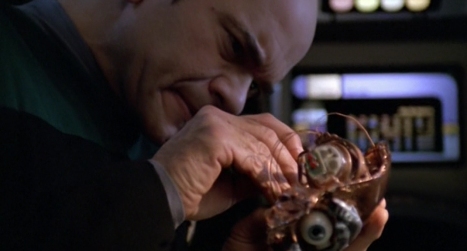
Seven and the EMH never saw eye-to-eye.
The fact that Timeless exists as a “very special episode” is something of a marker of how closely tied Voyager was to the syndication market. There are lots of reasons to celebrate the one hundredth episode of a television series, but one of the primary considerations is syndication. In the context of eighties and nineties television, any television series that hit one hundred episodes was likely to live forever in syndication. Local affiliates could be relied upon to fill broadcast slots in the mid-afternoon or late at night with packaged reruns of classic shows.
Timeless acknowledges as much. The title suggests that Voyager has become “timeless”, an object detached from its broadcast moment and unstuck in time. (Of course, television shows are always a product of their time, but some age better than others.) Even the image of Voyager trapped under the ice suggests the best possible future for the series; a moment playing out for all eternity, its characters frozen in one-hundred-and-seventy eight moments that can be played and repeated forever. Voyager’s journey home would last longer than seventy years, it would echo in eternity.
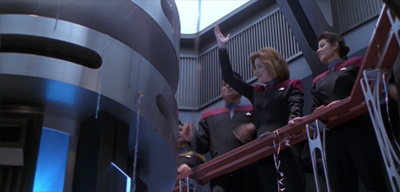
The show’s core appeal…
Indeed, the central theme of Timeless is that Voyager’s journey will continue at any cost. An attempt to take a shortcut home results in the death of every crew member on the ship. Even the characters who make it home (and find some sense of closure to their adventure) find themselves longing to return to that perpetual journey. Both future!Kim and future!Chakotay both separately acknowledge their desire to return the familiar security of that seventy-year status quo.
When future!Chakotay acknowledges that his attempt to save Voyager will re-write history that he never loves Tessa, she urges him on. “Your heart has always been here, on Voyager,” she assures him. “That’ll never change. This is where you belong.” Of course, Tessa never acknowledges that the original plan with the slipstream that drives the plot of the episode is to get Voyager back to Earth, and so past!Chakotay will most likely be leaving the ship no matter how this mission plays out.
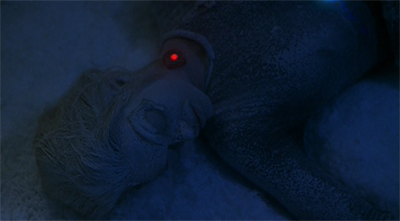
Frozen in time.
future!Kim harbours more of a death wish, soaking in survivor’s guilt. “At least you weren’t buried under twenty metres of ice,” the EMH reflects at one point. future!Kim responds, “You don’t know how many times I wished I was.” Obviously, this is an expression of future!Kim’s guilt over his role in the events that led to the crash, but it also speaks to the same idea that Tessa suggested to future!Chakotay. future!Kim and future!Chakotay belong on Voyager, on a seventy-year journey to the Alpha Quadrant.
This is perhaps best reflected at the climax of the episode. future!Kim initially plans to send data to Seven of Nine that will allow Voyager to stabilise the quantum slipstream and complete their journey to the Alpha Quadrant. Such a plan would allow Voyager to return to Earth along with the Delta Flyer, thus completing the journey home. This would shatter the familiar status quo as surely as the mass murder of every living person on the ship. The writers would have to deal with the consequences of that decision.

Party to murder.
However, future!Kim’s plans backfire. He sends the information back to Seven of Nine, and Voyager crashes anyway. He confesses that he spent a decade working on the math, but it simply does not work. The episode never explains future!Kim’s error, but the internal logic is quite clear. The narrative logic of Timeless would never allow future!Kim to get Voyager home less than a quarter of the way into the fifth season of a show that would run for seven years. The best that future!Kim can do is to force Voyager out of the slipstream, effectively resetting the status quo.
Of course, technically the crew make it a little closer to home. “Our slipstream flight may have been brief, but it took nearly ten years off our journey,” Janeway explains in her closing log entry. “I’ve given the order to dismantle the Quantum Drive until the technology can be perfected. Despite the setback, we have a renewed sense of momentum. It no longer seems a question of if we get home, but when.” In theory, it is akin to the little boost that Kes gave the ship in The Gift, nudging them past Borg space.

Time slipping by…
In practice, this boost means absolutely nothing. Janeway might be ten years closer to home, but there is no tangible sense of momentum. Voyager might be fifty years away from home rather than seventy, but that difference is immaterial. Voyager’s journey was always going to be seven years, and nothing in Timeless changes that. More than that, the jump in Timeless has no tangible impact on the journey. Voyager encounters the Malon again in Juggernaut, and faces off against the Borg in Dark Frontier, Part I and Dark Frontier, Part II. Voyager may as well be running in place.
There is something rather ironic and reflexive about the plot of Timeless. In many ways, Voyager is a show fundamentally about returning; it is a show about returning to the safe and the familiar, rather than exploring the new or the bold. Voyager heads backwards, rather than forwards, as literalised in the journey to the Alpha Quadrant. However, Timeless almost squares that metaphor. future!Kim and future!Chakotay have completed the return journey that began in Caretaker, but now they plan to return to the return. They are journeying back to the journey back.

That doesn’t wash.
As such, Timeless feels like a celebration of the perpetual and unending status quo on Voyager, a story that acknowledges the lack of any true forward momentum within the series. It is an episode that acknowledges (and even celebrates) the fact that Voyager will never get home no matter how much the show might tease it. The flashback sequences early in the episode even go so far as to wryly concede that this is a spectacular event. The crew are holding a party, throwing confetti and drinking champagne.
Within the context of the episode, this makes little sense. The crew did not throw similar parties when other opportunities to get home presented themselves. They did not clap and celebrate in Threshold or Hope and Fear. The only reason that they are celebrating is because this is the one hundredth episode of Voyager. This is a party that has nothing to do with the prospect of the crew getting home. Instead, it is a celebration of the show’s all-but-assured passage into the safety and security of syndication reruns.
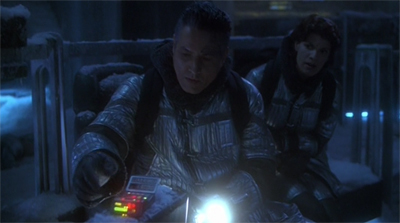
Chakotay has cooled on the idea of going home.
Voyager was a show that existed at a transitional moment for American television. Its genre contemporaries obviously included Deep Space Nine, but there were many other shows competing for oxygen in the second half of the decade. The massive (and often under-appreciated) success of The Next Generation had spawned dozens of imitators, encouraging both major and minor networks to experiment with genre series and storytelling. Science-fiction and horror had been largely absent from high-profile prime-time slots during the eighties.
Voyager was competing for exposure and audiences against television series like The X-Files, Babylon 5 and Buffy: The Vampire Slayer. These were series that were legitimately doing new and exciting things within prime-time television, and which would provide a foundation for a televisual revolution at the turn of the millennium. Even Deep Space Nine was trying its best to push storytelling forward within the Star Trek franchise, willing to experiment with a darker tone and more serialised narrative.

Just in case.
Naturally, there was a second revolution waiting in the wings. Timeless aired in November 1998, only two months away from the premiere of The Sopranos. This would lead the way for a whole slate of provocative serialised dramas, largely on cable networks, that would usher in the so-called “Golden Age of Television” including The Shield, The Wire, Mad Men, Boardwalk Empire and Breaking Bad. By the end of its fifth season, Voyager would arguably find itself behind the curve on two televisual revolutions.
In many ways, Voyager felt like a backwards-looking show from the moment it premiered. Not just because it was a show about literally crossing the galaxy to return to the familiar, and not just because it marked a conscious effort to recapture the “space western!” aesthetic of the original Star Trek right down to having a prominent Native American character, and not just because of the retro fifties and sixties b-movies aesthetic of episodes like Cathexis and Faces. More definingly, Voyager felt like a show anchored in the demands of the early nineties television market.

No champagne, no gain.
To be fair, there were reasons for this. The Next Generation and Deep Space Nine had aired in first-run syndication, a decision that allowed the creative team freedom to operate without being beholden to the demands of a particular network. The writers and producers still had to deal with the studio, but did not have to deal directly with network executives vying for creative control or trying to enforce their own vision on what the show should be. The Next Generation and Deep Space Nine were presented to networks as a bolder “take it or leave it” proposition.
In contrast, Voyager was wed to the nascent UPN. It was anchored to Paramount’s spectacularly misguided effort to create a fifth network, trying to break into a market dominated by the existing broadcasters, emboldened by the success of Fox. While Voyager was the crown jewel in UPN’s line-up during those early years, it was also subject to the ebb and flow of the network. Whatever the producers might say, it is hard to believe that The Next Generation or Deep Space Nine would have been drawn into the crass cross-promotion of Tsunkatse.
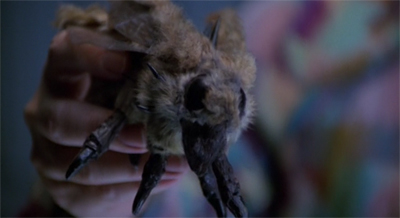
No flies on Neelix.
Well, one fly on Neelix.
So Voyager was unlikely to have ever been permitted the freedom to truly experiment with the form. The belief on the part of both the network and the studio was that they were creating a television series that would thrive in syndication, and that meant that the vast majority of episodes had to be self-contained. As Eric Hynes explains, channels did not always broadcast their syndicated shows in strict chronological order:
Thanks to exclusivity agreements, the relative bounty of episodes, and higher audience share, syndicators are more likely to maintain sequencing during an initial strip-syndication cycle. But once the exclusivity window closes and ratings settle, larger programming needs trump expectations for chronology. Individual episodes become more like movable units on a master schedule. Some viewers might still prefer to watch Roseanne in succession, but after many years and multiple cycles of syndication, such expectations are less intense.
For a show that was very consciously aspiring towards syndication, that was clearly designed to conform to the expectations of a drama that could be sold into syndication, it made sense to push away from serialisation and towards a more episodic structure. Ideally, Parallax and Renaissance Man could air back to back without confusing audience members too much; they might wonder where Kes went and who Seven is, but they would follow along easily enough.
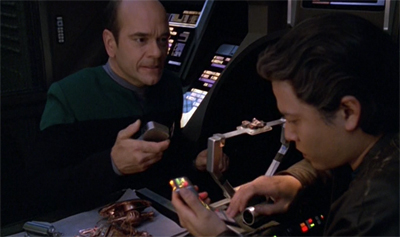
Putting it all together.
Voyager was shaped by this desire for a series that could thrive in syndication. It is tempting to be cynical about this fact, to treat it as a colossal miscalculation on the part of key creative personnel, a choice that effectively hobbled Voyager from the outset. However, it should be noted that syndication is a vital and important part of the history of Star Trek. The original series did not thrive on its first run in prime-time, but found an audience in day-time syndication. It is telling how many writers who worked on the Berman era came to Star Trek through syndication.
There is nothing wrong with the production team on Voyager seeking to future-proof the series, designing it in such a way as to ensure its longevity even beyond the initial seven-season run in prime-time. The problem is that the Voyager production team were looking to a very old model, planning the future by reference to the past. The Star Trek franchise was about imaging a brighter future, but Voyager could never look beyond the familiar and the safe. The syndicated market would not always provide the security that Voyager sought.

It’s all a bit of a blur.
Syndication would struggle as the twentieth century gave way to the twenty-first. As recently as June 2016, Anthony Crupi reported that scripted prime-time drama was struggling with the realities of modern television:
Over on the scripted side of the ledger, the quintessentially American format of the half-hour sitcom is fading fast. Per Nielsen, comedies in 2015-16 accounted for a scant 6% of all targeted GRPs, down from 10% five years ago. It’s a snake-eating-its-own-tail scenario in that the networks are programming far fewer comedies, thereby depressing the supply, while viewership of the comedies that do exist is at an all-time nadir. By way of example, seven of the 13 new broadcast comedies put up fractional ratings, averaging less than a 1.0 in the demo over the course of the season. (CBS’s Life in Pieces, which enjoyed the benefit of its Big Bang Theory lead-in, bucked the trend, wrapping its first season as network TV’s top-rated new series.)
NBC is notably deficient in the chuckles department, as sitcoms contribute just 4% of the network’s overall GRPs, but comedy is shrinking across the broadcast landscape. Of the 45 new scripted series slated to air next season, only 36% are comedies; just four years ago, the comedy-drama split was closer to 50/50.
“The shift in consumption and programming patterns has all but killed the 30-minute broadcast sitcom,” Mr. Nathanson notes. “Comedies have been hurt by a dearth of quality new programming. … There have been no new breakout shows to sell on the syndication market, [and] given the trends, we do not foresee any change to these dynamics.”
There was a sense that syndication would not be a viable or sustainable model for television production going forward, that the existing channels of distribution needed to change dramatically.
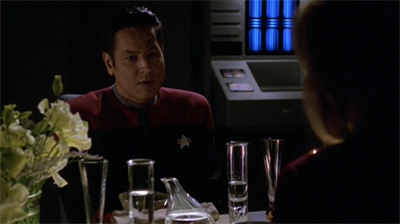
Nothing to celebrate.
A lot of this shift away from a sustainable model of television syndication is down to changes in the market place. Even in the late nineties, it would have been very difficult to discern the impending cultural shift. Netflix was only founded in August 1997, and would not introduce streaming until ten years later. Of course, the infrastructure of the nineties could not have supported it. By 1998, only half of all American adults were online. By the turn of the millennium, the average connection speed was less than seventy kilobytes per second.
Similarly, a home media revolution was still a long way away. DVD sales would not surpass those of VHS until 2001. TiVo would not make time-shifted viewing a concern until the early years of the twenty-first century. The first Star Trek DVD releases were the feature films, with Star Trek: First Contact and Star Trek: Generations releasing in October and November of 1998 respectively. DVDs packaging episodes of the original Star Trek would begin trickling out after the end of Voyager’s first season. Voyager would not see DVD releases until 2004.

Kim had enough difficulty getting his V-chip working.
Nevertheless, these changes to the market place would radically change the way in which people consumed television. As Joe Hill noted in April 2015:
There are several reasons why many reruns no longer have the firepower they once did. Streaming services such as Netflix, Amazon and Hulu carry reruns of many popular shows, as well as their own original content. Plus, the amount of original programming on cable networks has increased, taking eyeballs away from reruns.
“The more stuff that ends up on Netflix, the more viewers move there and the more holes you will get in your traditional business,” said Todd Juenger, a Bernstein Research analyst.
This can set off a vicious cycle: If viewers no longer flock to reruns, then cable networks will likely pay less for them and focus more on original content. Studios will then need to make up for that lost revenue somewhere else, perhaps by striking earlier, more expensive licensing deals with more online video providers like Netflix. That helps beef up video alternatives like Netflix that are cannibalizing traditional linear TV viewing in the first place.
The simple truth of the matter is that the market for television consumption would dramatically change, and that those changes were just over the horizon.

“It feels like TV just exploded.”
Modern television is dramatically different than twentieth-century television. The existence of Netflix and DVD box sets has changed the way that television is designed. This change was not confined to cable boutiques or obscure shows. This would be most obvious in the way that 24 embraced serialisation and became one of the most popular shows on television, paving the way for the obsessive consumption and discussion of Lost.
Even relatively episodic series like CSI would come to embrace long-form storytelling, with season-long arcs and clear character evolution of time. More than that, the design of television changed dramatically. Because syndication was no longer the goal, there was less of a desire to churn out content to hit that magic number. DVD and streaming services made shorter-run shows viable, with the the fourteen episodes of Firefly proving popular enough to earn the series a feature film adaptation in Serenity.

“Get this into her head.”
The rules of the medium changed dramatically to reflect the shift away from syndication as an end goal of itself. Television seasons became shorter, running thirteen (or ten or eight) episodes instead of twenty-odd. It became common to split seasons across a year (or two) in order to spread the interest. Shows began taking gap years and haitises between production, forcing fans to wait years for the next season.
All of a sudden, the emphasis was on producing more content rather than encouraging long-runners. Although there is more prime-time scripted television than ever before, in this era of so-called “Peak TV”, there is also a much higher rate of cancellation and a tendency to truncate season orders. The goal is no longer to develop a number of series that can sustain hundreds of episodes, the goal is to create a diverse range of narratives that can be packaged for streaming or home media.

“The computer is frozen.”
Only a decade and a half after the end of Voyager, it would seem rare for a major genre television series to hit that magic number of one hundred episodes. As Marah Eakin reported from the celebrations around Once Upon a Time‘s one hundredth episode, even those in the industry are keenly aware of this shift:
Precious few shows make that 100th episode benchmark these days, especially if you’re not counting daily programs like Wheel Of Fortune or Dr. Phil. It’s even rarer for a drama—and in particular a family-friendly drama—to hit that mark.
That’s something the show’s creators and stars were particularly aware of at the show’s 100th-episode party, held two weeks ago in Steveston, British Columbia, where the show shoots. As ABC’s new network president Channing Dungey and Pixar Chief Creative Officer John Lasseter looked on, the show’s principal cast and crew celebrated the milestone with a cake, a champagne toast, and a cautiously optimistic outlook. On a red carpet outside the event, Edward Kitsis, one of the show’s creators, told The A.V. Club, “The opposite of [100 episodes] is cancellation and failure, so we’ll take this over that.” His partner, Adam Horowitz, chimed in, “When you create a series, you hope that you can have an idea that has many stories in it, and to actually get the chance to tell this many stories is mind-blowing and really humbling.”
Much of the cast echoed that sentiment, with Jennifer Morrison, who plays the show’s troubled heroine Emma Swan, telling The A.V. Club: “It’s just so cool to be a part of something that people want to watch 100 episodes of. It’s getting more and more rare as time goes on.” Calling out the difference between British and American television production, Rebecca Mader, who plays evil Witch Of The West Zelena, said, “100 episodes is such a monumental milestone in America. In England, we only do two seasons and then go, ‘finished!’ To make it that long is so unheard-of these days. Shows get cancelled after three weeks if they’re not performing.”
It is worth noting that there is a very real chance that Voyager might just be the last Star Trek show ever to hit one hundred episodes. (Star Trek: Enterprise came up just short, ending on ninety-seven episodes (and ninety-eight hours) with These Are the Voyages…)

A Tessa-ment to her loyalty.
To be fair, there is still a syndication market of sorts. The Walking Dead garnered headlines for its own impressive syndication deal. The Simpsons is still a pop culture juggernaut, landing a $750,000,000 syndication and video-on-demand deal with FXX. The Big Bang Theory was able to charge $2,000,000-per-episode when it went to syndication. There are arguments that advertisers still like syndication and reruns because audiences still watch them “live”, and so can’t fast forward through the commercials.
Still, these are the exceptions rather than the rule. Indeed, even the home media market has been affected by advances in streaming and video-on-demand. DVD sales dropped dramatically in the second decade of the twenty-first century, and blu ray sales never managed to make up the lost ground. It is almost impossible to express just how much the media landscape has changed since the early nineties, and how far behind Voyager was left standing.
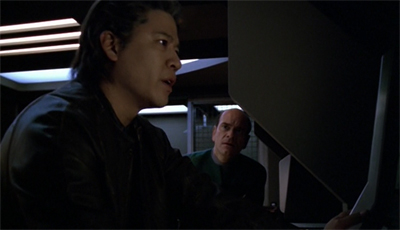
Coordinating their efforts.
The Star Trek franchise has struggled to keep pace with these changing developments. According to Robert Meyer Burnett, the high definition remastering of The Next Generation was unable to turn a profit due to the downturn in both syndication and home media:
The restoration remains an absolutely astonishing achievement in the annals of television and anyone watching the new versions of the episodes, can only marvel at the vast difference from the originals. Everyone involved at CBS Digital and the various other Post Houses who participated in the project deserve a hearty round of applause from fans the world over. At least the fans who appreciate and understand just how much work was done.
Unfortunately, during this same time, the popularity of streaming services skyrocketed, and popularity of physical media began to diminish. Sales of physical discs dropped 10% a year across the board, the younger generation thought putting discs in machines was too 20th Century and even the loyal Trek fan base asked themselves, “why do I have to buy TNG YET AGAIN?” I bought the VHS tapes, the Laserdiscs and the DVDs, so do I really need the Blu-rays…? I don’t even have a Blu-ray player. Won’t it all be on Netflix anyway?” The absolutely justified high price-point of the initial Blu-ray seasons also didn’t help sales.
As a result, it seems unlikely that CBS will green-light the high-definition remaster of Deep Space Nine or Voyager, which is a massive shame. It is even more frustrating because there should be a way to make this project viable in the current media climate, but the Star Trek franchise is too stuck on outdated models of media consumption.

“Have we found Joe Carey yet?”
After all, there is plenty of evidence that the Star Trek franchise is well-suited to streaming. After all, the franchise tends to attract fans interested in new and advanced technology, making it perfect for early adopters. Although Netflix does not release ratings, there is plenty of evidence to suggest that the company is very happy with how Star Trek performs on its service; they will be making every episode of Star Trek available to their international customers.
There were rumours of that the company was in preliminary talks with CBS about resurrecting Star Trek on television. When Star Trek: Discovery was announced, Netflix was very quick to snap up international viewing rights, like they had with other popular franchises like Breaking Bad or Better Call Saul. More than that, CBS is positioning Star Trek: Discovery as the cornerstone of its own streaming service CBS All Access, along with the Good Wife spin-off The Good Fight.
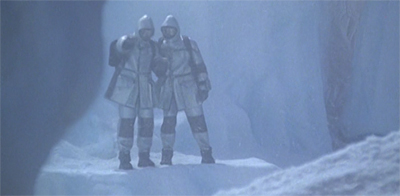
“We need to chill out.”
As an aside, with all of this in mind, there is something disheartening in CBS’ refusal to invest the money in future-proofing Deep Space Nine and Voyager for the streaming market. Netflix is leading the way in ultra-high-definition distribution, reflecting enhancements in infrastructure and technology that make it possible for more audiences to consume media in that format. More than four-fifths of Americans watch their television on high-definition sets. The average internet speed in the United States has tripled in the past six years.
Most of the television series designed to last have been remastered in high-definition; Friends, Seinfeld, Twin Peaks, The X-Files. It is quite simply unimaginable to plan a revival of a beloved property without taking the time (and investing the money) necessary to ensure that the existing back catalogue is future-proofed and ready to support viewers who may wish to indulge in a binge of the archives. High-definition is streaming the modern-day equivalent of syndication; it is the way for a property to soak into the zeitgeist after its initial run.
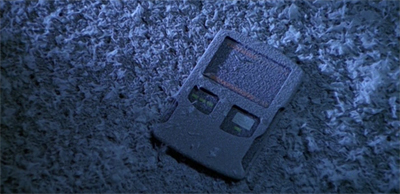
PADD_ing it out.
In many ways, these problems reflect a long-standing short-sightedness in the management and maintenance of Star Trek as a property. Paramount Studios is suffering financially from the lack of a major motion picture franchise, ignoring the fact that Star Trek should be able to provide a sustainable basis on par with the other major “geek” properties. After all, the franchise’s fiftieth anniversary seemed like something of a damp squib, particularly when compared to the fanfare around the fiftieth anniversary of Doctor Who.
Voyager is arguably a great example of this mishandling of the Star Trek franchise. Timeless is effectively an extended ode to serialisation, an episode that celebrates a model of syndication that was already in decline. It might have been impossible to predict the rise of Netflix and DVD in November 1998, but there were clear signs of changes in the market place. Timeless is an episode celebrating a mode of producing Star Trek that has not changed much since Michael Piller arrived on The Next Generation in September 1989.

Alas, poor Seven.
As such, there is something decidedly grim about the celebrations of Timeless, a fitting juxtaposition of the confetti with the long-dead bodies, of the champagne with the frost-covered sets. At the heart of Timeless is an exhumation, with future!Kim and future!Chakotay venturing back to the remains of their former ship. The key to their plan lies in the dead body of Seven of Nine. Repeatedly over the course of the episode, the camera focuses on the EMH holding her skull fragment in his hands, her cybernetic eye staring blankly into middle-distance.
As with Night, there is a strange a morbid atmosphere permeating the episode. What should be a joyous occasion is marred by encroaching darkness. The production team working on Voyager were aware that the Star Trek was arguably in decline on television, as reflected in declining ratings and slumping merchandise sales. There is a sense that the franchise is definitely and unequivocally coming off the high of the thirtieth anniversary, and that there is trouble ahead.

Meet and eat.
Indeed, it is worth noting that Timeless goes out of its way to illustrate how trapped Voyager is within the expectations and the framework of the franchise. At the climax of the episode, future!Kim and future!Chakotay find themselves being pursued by the USS Challenger. The Challenger is a Galaxy-Class Starship, evoking the USS Enterprise. Indeed, both the Challenger and the Enterprise share names with real-life space shuttles, although the shuttle Enterprise was named for Star Trek.
The Challenger is commanded by Captain Geordi LaForge, played by LeVar Burton. Burton would become one of three Next Generation regulars to reprise his role on Voyager, following Jonathan Frakes in Death Wish and preceeding Marina Sirtis in Pathfinder and Lifeline. To be fair, Deep Space Nine also featured appearances from three regulars on The Next Generation, but arguably in a more excusable pattern: Patrick Stewart appeared in the pilot, Emissary; Jonathan Frakes played Will Riker’s duplicate in Defiant; Worf became a series regular in The Way of the Warrior.
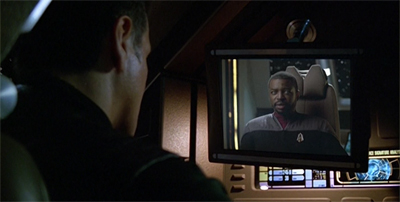
“Hey, this HD remaster of Next Gen is pretty good.”
Indeed, recurring Next Generation guest stars like Q and Barclay would become recurring fixtures on Voyager. In some ways, Voyager even inherited the Borg from The Next Generation and the Borg Queen from First Contact. As such, it seems fair to argue that Voyager existed in the shadow of The Next Generation. A more cynical commentator might argue that Voyager was ultimately an extension of The Next Generation featuring a cheaper cast, preserving a lot of what audiences expected from that earlier spin-off.
There is something evocative in the imagery of these characters trapped in a tractor beam by a Galaxy-Class ship, perhaps a literal expression of a deep-set anxiety about the relationship between Voyager and The Next Generation. It is worth contrasting the power of the Challenger in Timeless with the impotence of the Odyssey in The Jem’Hadar, a detail that perhaps reveals a lot about the differences in how Voyager and Deep Space Nine perceived their relationships with The Next Generation.

Tremendous pull.
Indeed, it could be argued that the pull of The Next Generation was a central weakness for Voyager. As Ronald D. Moore argued in The Fifty-Year Mission:
It should have been gold, but they got scared. Unfortunately, the fact that DS9 didn’t do as well as Next Gen scared them they didn’t want another dark show that wasn’t as successful. They wanted a show that was more like Next Generation and easier to swallow and where people didn’t have to think as much. So they drew all the wrong lessons. and said, “Let’s play it safe.”
In some ways, Timeless feels almost like a weird dream, touching on imagery that captures a lot of the simmering tensions within the series as a whole.
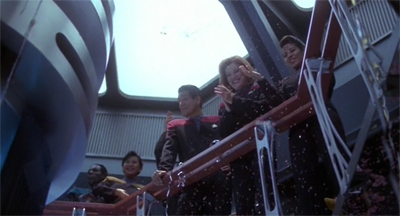
“You know we should probably try not to clog up the quantum slipstream with confetti, no?”
To be clear, The Next Generation cast a very long shadow. It is easy to lose sight of just how influential and successful that syndicated spin-off had been. It resurrected the idea of science-fiction on prime-time television during the nineties, demonstrating that it was possible to tell credible genre narratives in a respectable manner. The Next Generation was the highest-rated syndicated drama in the history of television. Its final season earned an Emmy nomination for Outstanding Drama Series, a remarkable accomplishment.
It seems churlish to complain about Voyager failing to live up to that older sibling, but it also only underscores how misguided the production team had been to follow The Next Generation so blindly. Voyager could never compete with The Next Generation, but the producers and the writers had decided to openly invite the comparison. Deep Space Nine has arguably aged so well because it was willing to push itself out of that shadow, instead of accepting its place within those boundaries.
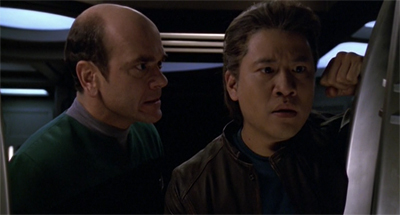
“Think of the Next Next Generation.”
This tension between The Next Generation and Voyager continues to the present day. Brannon Braga has argued that his work on Voyager was superior to his work on The Next Generation:
I think some of the stuff we did on Voyager was even more sophisticated from a storytelling point of view. You know, All Good Things… was just the beginning for me, I was just getting going. I wasn’t done! I really got into the stuff on Voyager. I honestly look at some of these Voyager episodes that I’m enormously proud of, like “Timeless“, the hundredth episode of Voyager.
That’s a time travel episode; it’s relatively simple, but it’s filled with striking imagery and character moments. The image of a frozen ship is just perfect…
The opening shot before the credits where it pans up…
Yeah. If that had been a Next Generation episode, it would be a classic. It would be ‘one of the good ones.’ I think a lot of it has to do with the crew. A lot of it has to do with it just being a different show, or maybe just being around too long. I stand by the body of work on Voyager as much as I do – if not moreso than The Next Generation.
There is a sense of an inferiority complex at work here, but it is only reinforced by the decision to make a cameo from a Next Generation crewmember so essential a part of such a pivotal episode.

Future imperfect.
Even still, Timeless is a striking piece of television. It often feels like something of a fairy tale. Timeless is a story populated with rich archetypal imagery, powered more by theme than by plot. There is something very primal about the idea of a literal exhuming of Voyager, of the ship trapped beneath the ice and awaiting discovery. There is also something very uncanny and unsettling in the imagery of the crew lying dead, preserved in the ice for more than a decade before being unearthed.
Voyager is typically a plot-driven show, one structured around action beats and story developments. Timeless works on a more instinctual and primal level. The recovery of Seven of Nine feels like a twenty-fourth century riff on Sleeping Beauty, particularly when her frozen body is placed in the drawer on the Delta Flyer. Of course, there is a more technological twist to the plot; the EMH does not play to literally revive Seven of Nine, but instead to user her connection to her past self to save the ship.
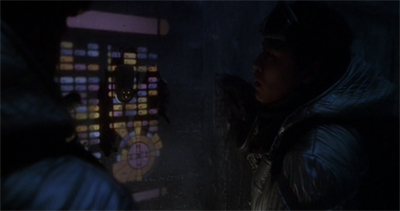
“Well, at least this computer hasn’t upgraded to Windows 10.”
Appropriately enough, according to Cinefantastique, the idea for Timeless came to writer Brannon Braga as an image rather than as a fully-formed story:
As was frequently the case during story development, executive producer Brannon Braga’s first idea for Voyager’s 100th episode was visual. Explain supervising producer and writer Joe Menosky, “The was Brannon tells stories, often he starts out with just an image and will figure out a story around it. In this case, it was Voyager buried under the ice.”
It would be up to the visual effects team, under producer Dan Curry, visual effects supervisor Mitch Suskin and coordinator Arthur Codron to come up with this image. This was a difficult task, which was eventually accomplished by means of a digital matte painting made by Eric Chauvin. Recalled Suskin, “The biggest problem with that was a conceptual problem. The script said, ‘They see Voyager under tens of metres of ice.’ There is no way you’d see anything. If you have ever seen a glacier, there’s no way you can see anything under a couple of meters of ice, let alone tens of meters. We talked to about it, and Steve Burg did sketches of the problems inherent with seeing Voyager under the ice. If you see it under the ice, it starts to look more like water than ice. We did some concept art showing the Voyager halfway sticking out of the glacier, half covered up. We thought it was really dramatic. But the image that Braga really wanted to see was Voyager under the ice.”
In some ways, this is a more experimental and evocative style of storytelling than Voyager usually attempts. Certainly, the image alone is bolder than most episode plots.

“You know, you think we’d be better at landings by this point.”
To be fair, there are still a few awkward beats in Timeless, when the episode leans a little bit too heavily into the technobabble. During the big party, Kim and Paris argue about the simulations that Paris has been running. “I ran a simulation last night and I discovered a point four two phase variance in the slipstream threshold,” Paris explains. “If we get knocked out of that slipstream mid-flight it could overload the quantum matrix.”
Similarly, the story of the episode reduces the dead body of Seven of Nine to a plot device. future!Kim and future!Chakotay plan to use her “interplexing beacon” (along with her time of death as derived from her “chronometric node”) to send a message back to their earlier selves. There is nothing inherently wrong with this, given that the plot needs some basis in pseudo-science to explain how future!Kim and future!Chakotay can avert disaster.

“Cool it, Harry.”
However, there is something a little awkward in the lack of emotion involved. future!Chakotay acknowledges that his discover of Seven’s body “isn’t exactly a happy reunion”, but the crew seem to treat her remains as if they are some random piece of alien technology. As far as future!Chakotay is concerned, “the hard part” of all this is the science involved in using her implants to “pinpoint the exact moment her cybernetic implants disengaged from her organic systems” so as to calculate a time of death “down to the millisecond.”
There is never a sense that future!Chakotay is talking about a person with whom he served, never a real sense of what it means for future!Chakotay to see Janeway’s body for the first time in about fifteen years. It all feels a little too neat, a little too convenient. future!Kim and future!Chakotay never seem like people who have stumbled across a mass grave filled with their friends and family. future!Chakotay never laments how he failed the Maquis who swore to serve him.

Top drawer.
To be fair, Timeless does allow future!Kim the opportunity to express his emotions. Timeless features Garrett Wang’s best work in the seven years on the show, playing future!Kim as a washed up and embittered Starfleet officer who blames himself for the death of his friends. The character of future!Kim as developed and explored in Timeless feels more nuanced and more compelling than the version of the character who appears in every other episode. It is hard to reconcile this tragic figure with the protagonist from Alter Ego or Favourite Son.
It is a shame that none of this was allowed to bleed back into the character, that episodes focusing on Harry Kim between Timeless and Endgame would return to the very naive and generic interpretation of the character that was supposedly retired with Demon. After all, it would be infinitely more interesting to watch future!Kim than it would be to sit through The Disease or Nightingale. There is something frustrating in how Timeless hints at a more compelling version of Harry Kim, only to wipe that version from existence at the end of the episode.
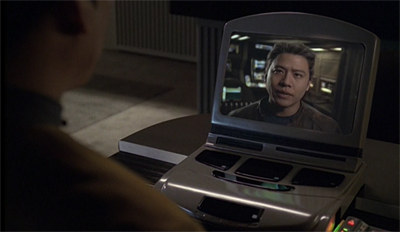
To thine own self…
It is no small irony that Timeless should focus on two of the most neglected members of the primary cast. As Joe Menosky acknowledged to Cinefantastique, the version of Kim presented in Timeless was very much inspired by some of Garrett Wang’s earlier work in The Killing Game, Part I and The Killing Game, Part II:
There is an interesting point that reveals the – I’d almost say – interactive and organic nature of working on a series. Basically, a year ago Brannon and I were as down on Kim’s character as any character. We love Garrett, but Kim never did it for us. If someone would have said to me, ‘The hundredth episode, next season, is going to feature Garrett and Ensign Kim,’ I would have laughed. It was just inconceivable.
When we did The Killing Game, who was the one character that didn’t get to dress up in a World War II period costume, and have an adventure? It was Kim. We stuck his ass on the bridge, and we just didn’t care. A really interesting thing happened. We ended up being short in that episode. Because all the World War II sets had been struck, and it was elaborate amounts of costume to do anything in the period anyway, we were stuck with a few minutes of scenes we had to write, and no one but Ensign Kim. Because he was messed up, because these guys had been smacking him around, and he was rebellious but he still had to knuckle under, we saw this other side of Kim. It was a tough side to him that we had never seen before, and we really liked. That takes everybody by surprise, no one more so than us. You see him in dailies, and you see him in the episode, and you go, ‘That’s cool.’ In a funny way, he future Kim in Timeless was directly inspired by the belted-around Kim and edgy Kim from The Killing Game.”
This is the sort of approach that Voyager should have been using more regularly with its primary cast, looking to their strengths and tailoring the roles around that. The writers on Deep Space Nine understood this, most notably in adjusting characters like Jadzia Dax and Gul Dukat to play to the strengths of the performers. Voyager did this all too rarely.

Drinking it all in.
In some ways, it could be argued that Timeless is the archetypal Voyager episode. Certainly, it is populated with plot and structural elements that capture the recurring interests of the production team. It is a time travel episode that has a reset button, even if Kim does get to watch a recording from future!Kim. Voyager was very fond of both time travel and reset buttons, combining them in episodes as early as Time and Again and as popular as Year of Hell, Part I and Year of Hell, Part II.
Indeed, Timeless is something of a template for the series finale. Endgame will combine elements of Timeless with elements of Dark Frontier, Part I and Dark Frontier, Part II, featuring a member of Voyager’s crew manipulating history while also wrestling with the Borg Queen. Timeless is such an archetypal episode of Voyager that it effectively establishes a blueprint for the last ever episode of Voyager. There is something almost tragic in that. Not only is Timeless an ode to being in episodic adventures, but it will also be repeated as the very last episode.

Snow coming back from that.
Voyager‘s fixation with time travel is interesting, if only because it proves a point of contrast with The Next Generation. While The Next Generation featured a number of time travel episodes, it did not feature them with anything like the regularity of Voyager. As Joe Menosky conceded to Cinefantastique, one of the challenges with Timeless was telling a novel time travel story:
“This is an interesting little bit of history. Back when were on TNG fourth season, Rick Berman had basically said, ‘No time travel stories.’ He thought it was hokey, and he just didn’t want to hear about it. Eventually, when you are doing hundreds of episodes, and you are running out of ideas, time travel and mucking about with time finally got opened, and we went with it. On Voyager finally we’ve run out of ways to tell a credible time travel story, because it’s all been done. Timeless is like a post-modern time travel story, because nobody is actually travelling through time. There’s a message sent through time. The beats of a time travel story, the twists and turns are all so known that there is almost no way to do it with any degree of surprise.”
This distinction feels academic at best. Living Witness is an episode set in the future that avoids any form of time travel, instead featuring the metaphorical rewriting of history. Timeless avoids any direct interaction, but still features characters in the future altering the past for their own ends. Timeless is a time travel episode, like many Voyager episodes before and after it.

“We had a heated debate about this plan.”
To be clear, there is nothing wrong with time travel episodes. Deep Space Nine was able to do a number of time travel episodes very effectively, including Past Tense, Part I, Past Tense, Part II, Visionary and Little Green Men. In some respects, even The Visitor is a time travel episode, a story to which Timeless is arguably indebted. However, there is something wrong with returning to these plot points over and over and over again.
This is perhaps what is most frustrating about Timeless. It should be a big event episode, with the rewriting of the space-time continuum and the destruction of an entire timeline. However, that has happened far too often on Voyager, so the effect if undercut. It is not even the only time travel episode this season, with Relativity revisiting that particular well. Similarly, it is an episode that features the destruction of Voyager and the death of everybody on board. That should be a big deal, but it effectively happens again in Course: Oblivion.

No time like the future.
This is perhaps the biggest issue with Timeless. It should be a truly momentous and special occasion, but the idea of Voyager frozen in time and stuck in place feels far too much like business as usual, and just a little bit too true to life.
Filed under: Voyager | Tagged: Brannon Braga, harry kim, reset button, streaming, syndication, the future of star trek, the next generation, time travel, timeless, voyager |




















“Television seasons became shorter, running thirteen (or ten or eight) episodes instead of twenty-odd.”
This is going to be unpopular but I think this shift has been a very mixed blessing. Certainly ‘Buffy the Vampire Slayer’ or ‘Deep Space Nine’ or ‘The X-Files’ had episodes that felt like filler… but same broad sweep allowed for room for a lot of worldbuilding, side character development and experimentation.
That’s fair. I mean, I like the freedom in style and tone that “we have to do [x] episodes, so just go with it!” allows. How many great standalone X-Files would you lose if you truncated the seasons to thirteen episodes. I can honestly think of only maybe three or four episodes that I’d cut from the third season of TNG, the fourth season of DS9 or the fifth season of DS9.
That shot of her eye was alarming when it aired. Nice to see Star Trek still had some balls. (no pun intended)
“producers and the writers had decided to openly invite the comparison.”
VOY at times feels like the last season of a sitcom where the writers are just going nuts.
From the numerous holodeck parodies, to BE’lanna co-writing a stage play on the Borg, to the Doctor singing about Pon Farr (“Paris please find a way, to load a hypospray…”), to the ECH’s (bad) impression of Captain Kirk, to the “Alpha Quadrant Summit’ in Flesh and Blood, to the pantomime Klingons in Prophecy… and I’m forgetting a dozen others, I’m sure.
To put it another way. Enterprise treats Star Trek as a type of stodgy museum piece. Voyager treats it like Disneyworld.
I don’t know, I think that the third and fourth seasons of Enterprise do some fun stuff with the expectations of the mythos.
I think this episode is one of Voyager’s finest. The effects are excellent, but used to help the story rather than the other way around. The humor is well done, I still enjoy Seven’s drunken speech: “We are one. We are one.” Also, Harry actually has something to do, and Garrett Wang for once rises to the occasion. The only thing I could fault for it would be the reset button, but honestly it doesn’t bother me as much here. The only bad thing is I think this would have made a much more interesting finale than the finale we ended up getting in Endgame. Certainly Harry’s reason for wanting to alter the timeline is more compelling than Janeway’s.
I don’t know, I thought Janeway’s motivations in Endgame made a certain amount of sense. EVERYTHING ELSE IN THE EPISODE was the problem.
I would rather have watched a seasons 5-7 of Voyager learning to survive on an ice world. The image was provocative indeed. But then we just have yet another time travel episode, with crewmen violating the “Temporal Prime Directive”, yet no 29th century people show up to arrest them for this – what a surprise!
Always nice to see George in a retrofitted Galaxy-class ship. LeVar Burton’s role as director makes his presence have a sort of meta-context. It’s almost like he’s showing up to shut down the stupid time travel plot. Janeway even says (as is often the case in Trek) that we “shouldn’t think about it”, when it comes to time travel logical paradoxes. It’s like a slogan for the whole series – “Don’t think about it.”
This is my favourite iteration of Harry Kim. Wang suddenly was like…acting. Nice to see. I would rather have seen Harry Kim become a embittered dick who maybe leans on Tuvok for male leadership, rather than see him as an endless vanilla character.
Geordi*
Even when Seven of Nine is dead, Voyager relies on the magic cyborg abilities of her corpse to save everyone.
that few seconds of slip stream took 10 years …
they need what 70 years ?
why cant they repeat that few seconds of slip stream over and over again for 7 times ?
It’s best not to worry about such things, I think.